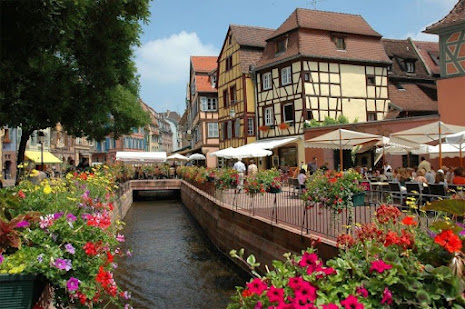Modern tourists know Colmar as the capital of Alsatian wine, an ultra-classy white variety.
====================================================================(in the Haut-Rhin department and Grand Est region of northeastern France) The town of Colmar looks as if it has been plucked from the pages of a medieval folk tale. At times the Route des Vins d’Alsace fools you into thinking it is 1454, and here, in the heart of the Old Town, the illusion is complete. Half-timbered houses in chalk-box colors crowd cobblestone lanes and bridge-laced canals, which have day-trippers wandering in a daze of neck-craning, photo-snapping, gasp-eliciting wonder.
+ Among the most quaint places in Europe, Colmar is known for its beautiful historic districts, which feature buildings that date back about a thousand years. Some museums feature toys, chocolates, and some serious pieces of historical information. All these attractions are complemented by beautiful natural scenery, given that this town is located 42 miles (68 km) south-southwest of Strasbourg, 10 miles west of the Rhine River, bordering the German frontier and a few miles east of the foothills of the Vosges mountains. It is also on the main railway from Strasbourg to Mulhouse and Basel, Switzerland.
+ The first mention of Colmar is found in a chronicle of the Saxon wars of Charlemagne, emperor of the West (from 800–814). In 1226 Colmar was raised to the status of an imperial town by the Holy Roman emperor Frederick II and was surrounded by defensive walls. Civil rights were granted to it by Rudolf of Habsburg in 1278. In 1632, during the Thirty Years’ War, it was occupied by Sweden. Louis XIII of France took the town under his protection in 1635; it was later annexed by France during 1648–78. (Colmar was twice annexed by Germany: from 1871 to 1919 and again during World War II.)
+ Colmar’s many fountains, ancient churches, and Alsatian Renaissance houses have made it a center of tourism. The Musée d’Unterlinden, formerly a convent, houses the 16th-century Isenheim Altarpiece, the masterwork of the German religious painter Matthias Grünewald. The home of the sculptor of New York City’s Statue of Liberty, Frédéric-Auguste Bartholdi, who was born in Colmar in 1834, is a museum. The city adopted the Protestant Reformation in 1575, long after the northern neighbors of Strasbourg and Sélestat. During the Thirty Years' War, it was taken by the Swedish army in 1632, which held it for two years. In 1634, the Schoeman family arrived and started the first town library. In 1635, the city's harvest was spoiled by Imperialist forces while the residents shot at them from the walls. In 1854 a cholera epidemic killed many in the city. With the rest of Alsace, Colmar was annexed by the newly formed German Empire in 1871 as a result of the Franco-Prussian War and incorporated into the Alsace-Lorraine province. Though It returned to France after World War I, it was annexed by Nazi Germany in 1940, and then reverted to French control after the battle of the "Colmar Pocket" in 1945.










